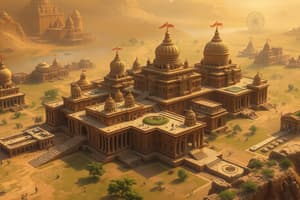Podcast
Questions and Answers
What was a characteristic of the architecture of the Indus Valley Civilization?
What was a characteristic of the architecture of the Indus Valley Civilization?
- The use of fired bricks and standardized sizes and shapes (correct)
- The construction of grand temples and monuments
- The use of elaborate arches and domes
- The use of stone as the primary building material
What feature of the Indus Valley Civilization's urban planning is notable for its efficiency?
What feature of the Indus Valley Civilization's urban planning is notable for its efficiency?
- Well-organized drainage systems (correct)
- A complex system of canals
- A series of imposing city walls
- Elaborate palaces for the ruling class
What is a notable feature of the Indus Valley Civilization's water management system?
What is a notable feature of the Indus Valley Civilization's water management system?
- The heavy dependence on rivers for water supply
- The development of complex irrigation systems (correct)
- The use of advanced desalination techniques
- A reliance on seasonal rainfall
What is a notable aspect of the Indus Valley Civilization's cities?
What is a notable aspect of the Indus Valley Civilization's cities?
What has not been mentioned about the Indus Valley Civilization?
What has not been mentioned about the Indus Valley Civilization?
What was the capacity of the Great Bath at Mohenjodaro?
What was the capacity of the Great Bath at Mohenjodaro?
What was the primary source of the Indus Valley Civilization's economy?
What was the primary source of the Indus Valley Civilization's economy?
What was the primary use of the Indus script?
What was the primary use of the Indus script?
What was a common artifact produced by the Indus Valley Civilization?
What was a common artifact produced by the Indus Valley Civilization?
What was the Indus Valley Civilization known for its use of?
What was the Indus Valley Civilization known for its use of?
Study Notes
Indus Valley Civilization: Urban Planning, Architecture, Trade, and Economy, Writing System, and Artifacts
The Indus Valley Civilization, also known as the Harappan Civilization, is one of the world's oldest civilizations, dating back to approximately 2600-1900 BCE. It was a center for art, culture, and architecture, with urban planning and architecture being notable aspects of this civilization. The civilization's cities boasted well-planned networks of sewerage systems, public and private baths, and an efficient water management system, including numerous reservoirs and wells.
Urban Planning
The Indus Valley Civilization was notable for its urban planning, which included well-planned cities with a grid-like layout, straight streets, and well-organized drainage systems. The cities were equipped with public and private baths, and a well-planned network of sewerage systems through underground drains built with precisely laid bricks. The people were familiar with water management and had developed advanced irrigation systems, leading to the development of complex urban societies.
Architecture
The Indus Valley Civilization is known for its advanced architectural techniques, which included the use of fired bricks and standardized sizes and shapes. The cities were well-planned, with streets laid out in a grid pattern and houses built with fired bricks. The civilization also constructed large public buildings, such as the Great Bath at Mohenjodaro, which was a large, rectangular building with a capacity of 7.2 million gallons of water.
Trade and Economy
The Indus Valley Civilization's economy was centered on animal farming and agriculture, with crops like wheat, barley, pulses, and other plants being grown. The civilization's economy was also supported by trade, with evidence of trade with other parts of the world. The people of the Indus Valley Civilization used carts and ships for transportation, which allowed them to trade various products with other regions.
Writing System
The Indus Valley Civilization had a writing system, but it has not yet been fully deciphered. The civilization used a script known as the Indus script, which has been found on seals, pottery, and other artifacts. The script is believed to have been used for record-keeping, trade, and communication.
Artifacts
The Indus Valley Civilization produced a variety of artifacts, including pottery, metalwork, and stone tools. Pottery was a common artifact, with the civilization producing a variety of shapes and sizes. Metalwork, including jewelry and tools, was also produced, and the civilization was known for its use of copper. Stone tools, such as axes and chisels, were also used by the civilization.
In conclusion, the Indus Valley Civilization was a remarkable civilization that contributed to the development of urban planning, architecture, trade, and economy. The civilization's writing system, although not yet fully deciphered, provides insights into their record-keeping and communication practices. The civilization's artifacts, including pottery, metalwork, and stone tools, provide a glimpse into their daily life and technological advancements.
Studying That Suits You
Use AI to generate personalized quizzes and flashcards to suit your learning preferences.
Description
Test your knowledge on the Indus Valley Civilization, focusing on its urban planning, architecture, trade and economy, writing system, and artifacts. Learn about this ancient civilization's well-planned cities, advanced architectural techniques, economic activities, mysterious writing system, and various artifacts through this quiz.




